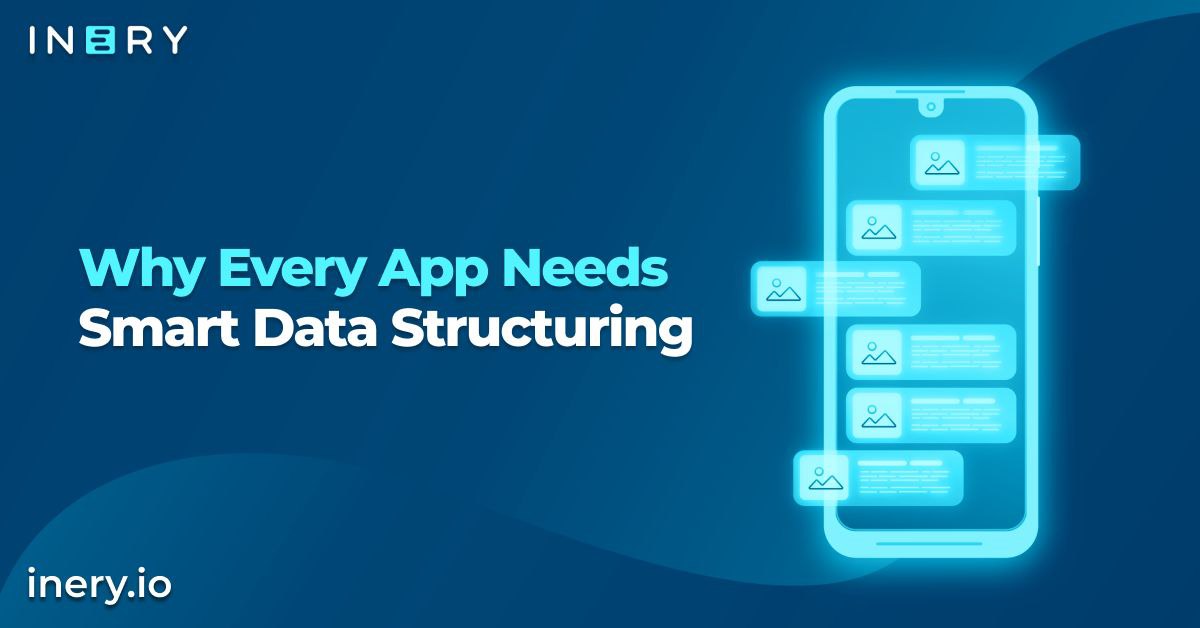In a world where apps power everything from our social lives to our shopping habits, one crucial element keeps them running smoothly: data. Not just data itself, but how that data is organized, managed, and made accessible. Enter smart data structuring, a concept that’s less about flashy tech jargon and more about creating a foundation that every app needs to succeed.
In this blog, we’ll explore what smart data structuring is, why it’s essential, and what happens when it’s ignored.
What Is Data Structuring?
At its core, data structuring is about organizing information so it’s easy to access, analyze, and use. Imagine trying to find a specific file in a cluttered desk drawer. It’s frustrating, time-consuming, and often impossible without some kind of system in place. Data structuring is the digital equivalent of tidying up that drawer so you can locate exactly what you need in seconds.
Applications generate enormous amounts of data, from user profiles to real-time analytics. This data needs to be organized into structures like tables, graphs, or trees to ensure it can be processed efficiently. Think of a streaming app. Every time you open it, it knows your preferences, recommends new shows, and remembers where you left off. This isn’t magic – it’s smart data structuring in action.
The Problem With Poor Data Structuring
Unfortunately, not all apps get it right. Poorly structured data is like a poorly written recipe: the ingredients might be there, but without clear instructions, the outcome is a mess. Apps that lack smart data structuring often face significant challenges.
For one, performance takes a hit. Users expect apps to be lightning-fast, but disorganized data makes even simple tasks like searching for a product or loading a feed painfully slow. Imagine trying to scroll through an app, only for every swipe to take a full second to load new content. Most users would close the app and never look back.
Another issue is scalability. Apps grow. More users, more features, more data. Without smart data structuring, this growth becomes unmanageable. Take a social media app that suddenly goes viral. If its data isn’t organized to handle a massive influx of new users, the app could crash, wiping out its chance to capitalize on that momentum.
And then there’s accuracy. Poor structuring leads to inconsistencies, errors, and even data loss. For example, an e-commerce app might mismanage inventory data, showing an item as in stock when it isn’t, leading to unhappy customers and logistical headaches.
Why Apps Need Smart Data Structuring
Smart data structuring solves these problems by ensuring that information is logically organized and easy to work with. It’s the secret behind the seamless experiences we’ve come to expect from our favorite apps.
When an app uses smart data structuring, performance improves dramatically. Tasks like searching for a product, pulling up past transactions, or loading a personalized dashboard happen in milliseconds. For the user, it feels effortless. For the app, it’s the result of meticulous planning.
Smart structuring also supports growth. A food delivery app, for instance, needs to handle an ever-growing database of restaurants, customers, and orders. With a well-organized structure, scaling up is smooth, even during peak usage times like Friday nights or public holidays.
Lastly, smart data structuring enhances reliability. When an app has clean, well-structured data, errors become rare. A banking app with smart structuring ensures that every transaction is recorded accurately, giving users peace of mind.
What Happens Without It?
Without smart data structuring, apps face real consequences. Take the example of a health and fitness app that tracks user activity and offers personalized recommendations. Without a solid structure, the app might fail to load historical data, recommend inaccurate exercises, or even lose user progress entirely. The result? Frustrated users who abandon the app for one that works better.
Even worse, the app’s developers spend more time troubleshooting and fixing issues than improving the user experience. It’s a vicious cycle that costs time, money, and reputation.
For businesses, the stakes are even higher. An app with poor data management can erode trust and lose revenue. Consider a ride-sharing app that frequently miscalculates fares or matches users with drivers far from their location. These missteps add up, pushing customers toward competitors.
How Inery DLT Offers a Smarter Approach
Enter Inery DLT, a decentralized solution that redefines how apps manage data. While traditional systems rely on centralized databases, Inery leverages blockchain technology to offer something more secure, efficient, and flexible.
At its core, Inery helps apps organize data in a way that prioritizes speed and security. For example, imagine an online gaming app where users rely on real-time updates. Inery’s system ensures that every player’s data, whether it’s high scores or in-game purchases, is accurately stored and retrieved without delays.
Another key advantage of Inery is its emphasis on decentralization. Instead of storing all data in a single, vulnerable location, Inery’s system distributes it across multiple nodes. This setup not only enhances security but also reduces downtime. For instance, if a logistics app needs to track shipments globally, Inery ensures that the system remains operational even if one server goes offline.
Inery also offers unparalleled data sovereignty. This means app developers retain full control over their data assets, an increasingly important consideration in a world where privacy concerns dominate headlines. An education app, for example, can use Inery to protect sensitive student information while still delivering seamless performance.
What sets Inery apart is its ability to integrate easily with existing infrastructures. Developers don’t need to overhaul their systems to benefit from its capabilities. Whether an app is built on Web2 or transitioning to Web3, Inery bridges the gap, ensuring a smooth experience for developers and users alike.
Conclusion
Smart data structuring isn’t just a nice-to-have. It’s a must-have for any app that wants to thrive! It’s what keeps apps fast, scalable, and reliable in a competitive landscape. Ignoring it leads to slow performance, frustrated users, and missed opportunities.
That’s where Inery DLT comes in. With its decentralized approach, Inery provides a solution that prioritizes speed, security, and control. It’s a tool for developers who want their apps to not just function but excel. From gaming platforms to e-commerce giants, the applications are endless.
In a world where data is everything, smart structuring is the foundation that apps can’t afford to ignore. And with Inery, they don’t have to.

Inery•
1 year ago
Why Financial Institutions are Turning to Blockchain for Secure Data Storage
As cyber threats escalate and data privacy laws tighten, financial institutions are turning to blockchain for a solution. Read our in-depth analysis on how blockchain technology offers enhanced security and operational efficiency in data management. ...READ MORE

Share

Inery•
3 years ago
An Overview of IneryDB: Decentralized Database Management Solution
Addressing the concerns persisting in the centralized and distributed infrastructure. ...READ MORE

Share

Inery•
2 years ago
How Decentralization Empowers Digital Freedom: The Data Rebellion
In the Data Rebellion, decentralization liberates, reshaping how individuals and businesses own data and experience digital freedom. ...READ MORE

Share

Inery•
2 years ago
DBMS Showdown: Comparing the Best 4 Systems for 2023
Here’s a detailed look at the best database management systems (DBMS) on the market. Compare their pros and cons, use cases, and more. ...READ MORE

Share
Most popular today



-1693472387.png)